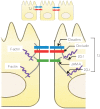Intestinal permeability regulation by tight junction: implication on inflammatory bowel diseases - PubMed (original) (raw)
Review
Intestinal permeability regulation by tight junction: implication on inflammatory bowel diseases
Sung Hee Lee. Intest Res. 2015 Jan.
Abstract
Epithelial tight junctions (TJs) are the key structures regulating paracellular trafficking of macromolecules. The TJ is multi-protein complex that forms a selective permeable seal between adjacent epithelial cells and demarcates the boundary between apical and basolateral membrane domains. Disruption of the intestinal TJ barrier, followed by permeation of luminal noxious molecules, induces a perturbation of the mucosal immune system and inflammation, which can act as a trigger for the development of intestinal and systemic diseases. Inflammatory bowel disease (IBD) patients demonstrate increased intestinal paracellular permeability. Although it remains unclear whether barrier dysfunction precedes disease or results from active inflammation, increased intestinal TJ disruption is observed in IBD patients suggest that dysregulation of TJ barrier integrity may predispose or enhance IBD progression. Therefore, therapeutic target to restore the TJ barrier integrity may provide effective therapeutic and preventive approaches against IBD. This review discusses the molecular structure and regulation of intestinal TJs and the involvement of intestinal TJs in IBD pathogenesis.
Keywords: Inflammatory bowel diseases; Intestinal barrier function; Intestinal permeability; Paracellular permeability; Tight junctions.
Conflict of interest statement
Conflict of interest: None.
Figures
Fig. 1
Molecular structure of the intracellular junction of intestinal epithelial cells. The tight junctions (TJs), multiple protein complexes, locate at the apical ends of the lateral membranes of intestinal epithelial cells. The TJ complex consists of transmembrane and intracellular scaffold proteins. The transmembrane proteins (claudins, occludin, and junctional adhesion molecules [JAMs]) create a permselective barrier in the paracellular pathways. The intracellular domains of the transmembrane proteins interact with the intracellular scaffold proteins such as zonula occludens (ZO) proteins, which in turn anchor the transmembrane proteins to the actin cytoskeleton.
Fig. 2
Interaction of proteins with the integral scaffold tight junction (TJ) proteins, zonula occludens (ZO)-1, -2, and -3. ZO proteins carry 3 post-synaptic density 95/Drosophila disc large/zona-occludens (PDZ) domains, a Src homology-3 (SH3) domain, and a region of homology to guanylate kinase (GUK) from the side of the N-terminus. Several TJ proteins and cytoskeletal actin interact with the ZO proteins. JAM-A, junctional adhesion molecule-A.
Similar articles
- Regulation of intestinal epithelial permeability by tight junctions.
Suzuki T. Suzuki T. Cell Mol Life Sci. 2013 Feb;70(4):631-59. doi: 10.1007/s00018-012-1070-x. Epub 2012 Jul 11. Cell Mol Life Sci. 2013. PMID: 22782113 Free PMC article. Review. - Autophagy and tight junction proteins in the intestine and intestinal diseases.
Hu CA, Hou Y, Yi D, Qiu Y, Wu G, Kong X, Yin Y. Hu CA, et al. Anim Nutr. 2015 Sep;1(3):123-127. doi: 10.1016/j.aninu.2015.08.014. Epub 2015 Sep 1. Anim Nutr. 2015. PMID: 29767173 Free PMC article. Review. - Tight Junction Proteins and Signaling Pathways in Cancer and Inflammation: A Functional Crosstalk.
Bhat AA, Uppada S, Achkar IW, Hashem S, Yadav SK, Shanmugakonar M, Al-Naemi HA, Haris M, Uddin S. Bhat AA, et al. Front Physiol. 2019 Jan 23;9:1942. doi: 10.3389/fphys.2018.01942. eCollection 2018. Front Physiol. 2019. PMID: 30728783 Free PMC article. Review. - Tight junctions in the development of asthma, chronic rhinosinusitis, atopic dermatitis, eosinophilic esophagitis, and inflammatory bowel diseases.
Sugita K, Kabashima K. Sugita K, et al. J Leukoc Biol. 2020 May;107(5):749-762. doi: 10.1002/JLB.5MR0120-230R. Epub 2020 Feb 28. J Leukoc Biol. 2020. PMID: 32108379 Review. - Structure Composition and Intracellular Transport of Clathrin-Mediated Intestinal Transmembrane Tight Junction Protein.
Pan YY, Deng Y, Su S, Yin JH, Chen YH, Wang LC, Sun LH, Xiao WD, Du GS. Pan YY, et al. Inflammation. 2023 Feb;46(1):18-34. doi: 10.1007/s10753-022-01724-y. Epub 2022 Sep 1. Inflammation. 2023. PMID: 36050591 Review.
Cited by
- Natural plant polyphenols contribute to the ecological and healthy swine production.
Mei H, Li Y, Wu S, He J. Mei H, et al. J Anim Sci Biotechnol. 2024 Nov 4;15(1):146. doi: 10.1186/s40104-024-01096-3. J Anim Sci Biotechnol. 2024. PMID: 39491001 Free PMC article. Review. - The Effect of CKD-495, Eupacidin, and Their Marker Compounds on Altered Permeability in a Postoperative Ileus Animal Model.
Kim MJ, Hussain Z, Lee YJ, Park H. Kim MJ, et al. Medicina (Kaunas). 2024 Oct 18;60(10):1707. doi: 10.3390/medicina60101707. Medicina (Kaunas). 2024. PMID: 39459494 Free PMC article. - Dietary Fermented Blueberry Pomace Supplementation Improves Small Intestinal Barrier Function and Modulates Cecal Microbiota in Aged Laying Hens.
Qin B, Li Z, Zhu Q, Chen T, Lan W, Cui Y, Azad MAK, Kong X. Qin B, et al. Animals (Basel). 2024 Sep 26;14(19):2786. doi: 10.3390/ani14192786. Animals (Basel). 2024. PMID: 39409735 Free PMC article. - Regulatory effects of the p38 mitogen-activated protein kinase-myosin light chain kinase pathway on the intestinal epithelial mechanical barrier and the mechanism of modified Pulsatilla decoction in the treatment of ulcerative colitis.
Tingting WU, Xin Y, Huiping Z, Jinwei G, Hui Z, Peipei Z, Meng W, Guoqiang L, Hongwen S. Tingting WU, et al. J Tradit Chin Med. 2024 Oct;44(5):885-895. doi: 10.19852/j.cnki.jtcm.20240806.006. J Tradit Chin Med. 2024. PMID: 39380219 Free PMC article. - Crude Blueberry Phenolic Extracts Improve Gut Barrier Integrity and Exert Anti-Inflammatory and Antimicrobial Activity in an In Vitro Weaning Stress Model.
Nathan VB, Eckrote S, Li S, Reddivari L. Nathan VB, et al. Antioxidants (Basel). 2024 Aug 28;13(9):1044. doi: 10.3390/antiox13091044. Antioxidants (Basel). 2024. PMID: 39334703 Free PMC article.
References
- Turner JR. Intestinal mucosal barrier function in health and disease. Nat Rev Immunol. 2009;9:799–809. - PubMed
- Dunlop SP, Hebden J, Campbell E, et al. Abnormal intestinal permeability in subgroups of diarrhea-predominant irritable bowel syndromes. Am J Gastroenterol. 2006;101:1288–1294. - PubMed
- Bosi E, Molteni L, Radaelli MG, et al. Increased intestinal permeability precedes clinical onset of type 1 diabetes. Diabetologia. 2006;49:2824–2827. - PubMed
Publication types
LinkOut - more resources
Full Text Sources
Other Literature Sources
Molecular Biology Databases

